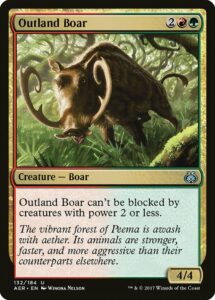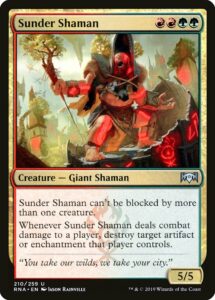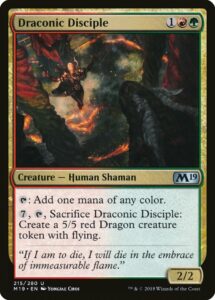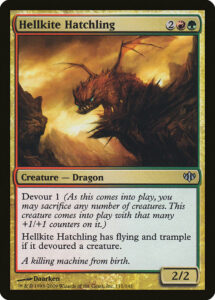Every year, Magic’s ten color pairs rotate through a variety of strategies in Limited. Some are mainstay archetypes, such as WB caring about lifegain or WU about Flying creatures. Some familiar strategies are loose, such as RW aggro, GU goodstuff, or UB control. Some are mini-mechanics that you don’t usually build a deck around, but which add some spice to focused decks, such as BR sacrifice in Theros Beyond Death or GW Counters in Core 2021. Some are novel or rarely used, such as RWU Cycling in Ikoria, BG Food in Throne of Eldraine, or GU draw-two-matters in Core 2021.
Every color pair cycles between focused archetypes and looser strategies and between familiar and novel mechanics. But one color pair stands apart from the rest.
Smash, Smash, and Smash Some More
Is shouldn’t be surprising to fans of Magic lore or worldbuilding that RG is the least tricky color pair. It’s the color of giant animals and the lawless, dispossessed Gruul Clans. It lives to foil blue mages’ insufferable need to demonstrate how smart and in control they are. But being defined by unsubtlety in principle makes the color pair the least subtle in practice—Gruul almost certainly has the lowest diversity in archetypes of all color pairs.
Gruul’s success in Limited tends more to depend on raw stats-to-costs ratios rather than combining disparate pieces into more than the sum of their parts. For every Creeping Trailblazer, Immerwolf, and Ruination Rioter there is whose power relies on an archetype, you’ll find far more creatures whose strength relies on power and toughness.
Big on Muscle, Less on Archetype
Consider Raging Regisaur, Rampart Smasher, and Grove Rumbler. All of them reflect their planes well and interact favorably with their sets’ mechanics. But their text boxes contain only a smidgen of their value. This makes flavorful sense—white, blue, and black have smaller creatures, so of course they need to eke out more value from text boxes than does RG. But the consequence of so much of the color pair’s potential being locked into pure stats leads to RG almost always having the same playstyle: play oversized creatures that cost 3, 4, and 5 mana. Sure, some cards like Grumgully, the Generous, Voltaic Brawler, and Hallar, the Firefletcher have high power level ceilings when built around, but their hoops are easy to jump through and their stats give them fairly high floors.
It’s fine for color pairs to get generically good, plane-agnostic cards like Outland Boar every now and then, but RG seems dominated by them. If I ask you to name the RG 3/3 for 3 with the random Trample ability, do you think of Khenra Charioteer, Relentless Hunter, or neither of those less-than-memorable cards? If I ask you what your favorite build-around archetypes are, will a RG one be in your top five? Your top ten?
The Spice of Life
There’s an argument to made that it’s good thing for RG to be so consistent across so many sets. This provides a consistent, streamlined play experience in an era when sets struggle to rein in complexity. The GRUUL SMASH! playstyle is a popular one, so it makes sense to keep featuring. And in an era where sets are built less around discrete color pairs, it makes sense to constantly have a RG beatdown archetype conveniently employ the Ferocious mechanic on 3+ cards.
I reject this line of thinking. RG isn’t the only color pair able to play the midrange beatdown role. But more importantly, both it and Magic suffer due to its lack of variety.
Magic’s entire business model involves balancing variety and familiarity. Magic prints hundreds of new cards annually yet cards created two decades apart are nevertheless recognizably of the same game. This balancing act holds true within sets, something we’ve talked about for years—replayability requires a sufficient variety of fun things to do without archetypes being so distinct that they never overlap.
Lorwyn Limited had really cool strategies, but they were so rigid that there wasn’t much strategy to draft or varied gameplay if you pursued the same archetype a second time. You would remember the archetypes, but the individual decks probably blended into each other. I believe that RG has been having this problem for years—its 4/4s and 5/5s for 4 blurring together because there’s so little to separate the cards individually or the RG archetypes collectively. Magic is done a disservice by having one color pair so consistently the same.
Subtlety and a Strong Suit
The future can go in a variety of ways. RG received some new archetypes in the past year and change: RG Elementals in Core 2020 and RG lands-in-graveyard from Modern Horizons were brand-new. So was non-humans-matter in Throne of Eldraine and Trample-matters in Ikoria: Lair of Behemoths (granted, both were relatively minor mechanics, but both likely have more design space). Landfall in Zendikar Rising and Ferocious in Theros Beyond Death (and Core 2021, War of the Spark—it’s almost evergreen now) were more familiar.
I think for RG to get more aspirational draft archetypes here and there, it needs formats where either another color pair picks up the Big Midrange slack (which any of the three other green pairs can do) or all creatures are smaller. There’s a finite amount of oomph one can give to a four mana uncommon 4/4 without breaking a format and almost none to a four mana 5/5. I’m not saying it’d be more fun or even make sense if RG were defined by Gray Ogres with upside for a set, but there are few ways to build around creatures that are mostly defined by their stats without using Ferocious for the umpteenth time.
Every color pair needs to ebb and flow over the course of each year, and RG’s intransigence is a pattern that ought to be broken more than it is. Magic will be better for it.
—Zachary Barash is a New York City-based game designer and the commissioner of Team Draft League. He designs for Kingdom Death: Monster, has a Game Design MFA from the NYU Game Center, and does freelance game design. When the stars align, he streams Magic (but the stars align way less often than he’d like).





